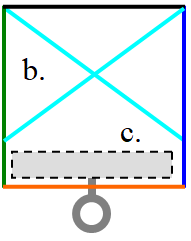- SUNY-Geneseo/Physics & Astronomy
- Bridge Building Contest
Design & Construction Suggestions
| 1. Even though the "score" is based on ratio, it's a losing strategy to not use all of your materials. Try to use most of your wood to get the strongest bridge rather than thinking merely about the scoring ratio. | |
| 2. A lot of students draw a full-scale image of their bridge on large paper to facilitate construction. Partly this will help make sure you have sufficient materials for each part of your assembly. | |
|
3. For discussion
purposes, imagine a bridge of more-or-less this form. Blue is the right
side, green is the left, orange is the floor, and pink is for the main axial
supports. Here are some common mistakes each year:
|
|
| a. If you assume the bridge is a truss (perhaps by using some free software for truss analysis), you will severely under-estimate the stress in the parts indicated with red ellipses. You want to make these 8 pieces a lot stronger than you’d otherwise think, because while this design is "trussy", it is not strictly a truss and bending moments are significant. | |
|
b.
When seen end-on, the structure looks like a rectangle and is very
susceptible to small asymmetries in loading. At a few cross
sections, you need to add one or both of the diagonal “counters”
indicated by the teal lines. But, they can’t let them reach all the
way to the bottom, because you need to leave space to insert the
testing device. c. Speaking of which, you need to make sure that you have a way to slide the testing device into the bridge pretty quickly. Most students come from the end of the bridge, but some bring it in at an angle through the bottom. Don’t forget the metal hook that projects below the testing device! |
 |
|
d.
Most students over-build the “floor”, making it almost solid with
popsicle sticks (orange). This is overkill; no bridge has ever
failed because these popsicle sticks broke. On the other hand,
many bridges have failed because the popsicle sticks had
insufficient overlap with the main axial members (see circular
inset). During testing, the main (pink) axial members flex outwards,
and sometimes the entire orange floor drops out of the bridge
without any piece actually breaking. e. Really tall and really short bridges never win. The ratio of length to height for most winners is between 2.5 and 3.5. |
 |
|
f. Smear a thin layer of glue on each of the two surfaces to be glued. Clamping so that the thin layer of glue is in serious compression is the key to good gluing. So, clamping requires that the glued surfaces be oriented correctly, which can be hard. Consider the 3 choices of intersection of blue and pink in this image. The left most connection is impossible to clamp with the glue in compression. The middle one can be clamped easily from the side, but maybe the tops of your (blue) sticks are hard to position like this. The third is like the first, but with some gussets on each side. You’d still glue the blue to the pink, but now the purple gussets will help carry some of the load, and they can be easily clamped in compression while the glue dries. However, as shown in the two end-views, if the width of the blue and pink sticks are different, gussets like this don’t work well.
|
|
| g. Metal binder clips make great clamps! |
 |
|
h.
Bridges usually warp while the glue dries, which is bad but not a
disaster. However, you do really need the four bottom corners to lie
in a single plane. Once all of the bridge is completely done drying,
you can add some shims (made from leftover sheet balsa) underneath
one of the four corners to keep the bridge from being wobbly.
Experiment to discover which corner, if any, is a little higher than
the others!
|
|


